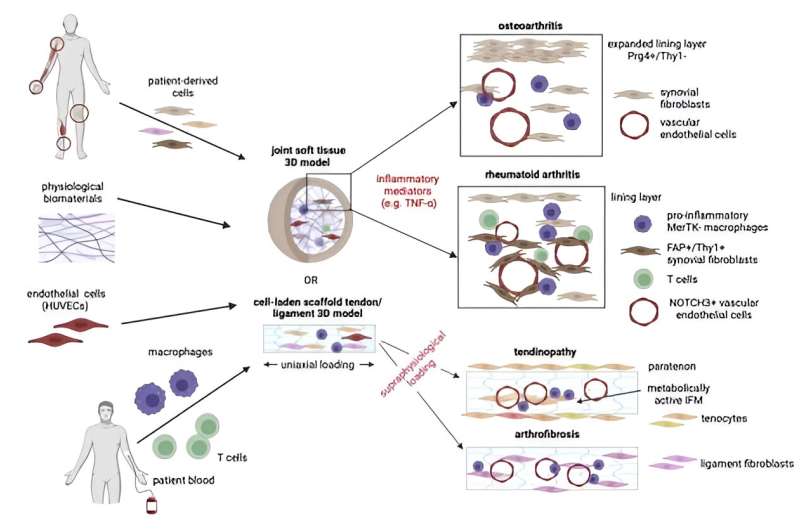This article has been reviewed according to Science X's editorial process and policies. Editors have highlighted the following attributes while ensuring the content's credibility:
fact-checked
trusted source
proofread
Custom-made 3D lab models could unlock the secret to soft tissue joint diseases

Research into the onset and progression of diseases affecting musculoskeletal soft tissues could be greatly advanced using novel 3D models, say researchers from the Nuffield Department of Orthopedics, Rheumatology and Musculoskeletal Sciences (NDORMS) at the University of Oxford. Their review has been published in The Lancet Rheumatology.
Diseases affecting joint soft tissues including osteoarthritis (OA), rheumatoid arthritis (RA), tendon injuries and arthrofibrosis cause significant pain and disability to patients and have high associated health care costs. Although research to understand their underlying causes and progression has resulted in some successful treatment strategies, effective therapies for these common diseases remain elusive.
Writing in The Lancet Rheumatology, senior author Prof. Stephanie Dakin at NDORMS reviews the recent developments in 3D in vitro (in the laboratory) models that are changing the face of research in soft tissue joint disease.
Current research to understand the cellular basis of joint diseases rely on human tissues, animal disease models and in vitro tissue culture models. But this area lags behind some other fields that have successfully used physiologically relevant 3D models to rapidly advance discovery of therapeutic targets.
State-of-the art in vitro human tissue models have successfully been used to mimic the structure of cancers, providing an understanding of the cellular and molecular mechanisms at play, and generating accurate predictions of patient response to treatment. The team of researchers at NDORMS claim that similar 3D in vitro models provide a promising approach to recreating the tissue microenvironment in a robust and scalable way to understand the disease in the context of a whole joint.
Stephanie explained, "3D models of the 'whole joint organ' typically include cartilage, synovium, tendons and ligaments, built around an extracellular matrix. From this we can learn how the tissues interact and how diverse cell types talk to each other and hopefully reveal the cellular and molecular mechanisms underpinning disease. If we can harness this information from these 3D models, we move closer to developing more personalized treatment plans for patients, identifying new ways to treat common painful musculoskeletal diseases."
More information: Peter A Johnson et al, Three-dimensional, in-vitro approaches for modelling soft-tissue joint diseases, The Lancet Rheumatology (2023). DOI: 10.1016/S2665-9913(23)00190-X. www.sciencedirect.com/science/ … 300190X?dgcid=author




















